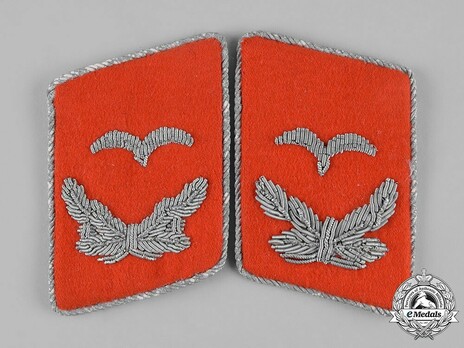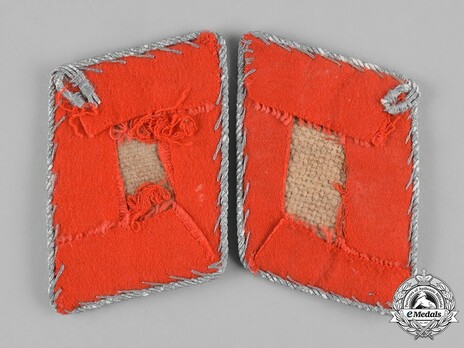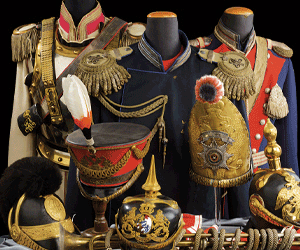Luftwaffe Anti-Aircraft/Artillery Leutnant Collar Tabs
SKU: 22.GOR.03.02.03.01.12.002
Estimated market value:


Estimated market value:
Attributes
Physical Description
Branch colour: red
History
The German Wehrmacht was composed of three main branches, the Heer (Army), the Kriegsmarine (Navy), and the Luftwaffe (Air Force). The Heer and Kriegsmarine uniforms were based upon the designs utilized by their predecessor organizations, the Reichsheer and the Kaiserliche Marine. Conversely, the Luftwaffe uniforms were based upon the uniforms worn in the sports and paramilitary organizations that were the forerunners of the Luftwaffe. The Luftwaffe uniforms were specifically designed to deviate from the designs of the other Wehrmacht service branches. It was also necessary that the uniforms differentiate between military and civilian pilots.
There were two main organizational precursors of the Luftwaffe, the German Air Sports Association (DLV or Deutscher Luftsportverband), and the National Air Raid Protection League (RLB or Reichsluftschutzbund). The DLV included both a civilian group and a secret military sub-group called the DLV-Fliegerschaft (Pilot Base).
The DLV and the RLB were officially founded in 1933, and they were used to secretly train members for future roles in the Luftwaffe. The DLV became obsolete after Hitler’s official introduction of the Luftwaffe in 1935, and it was disbanded in 1937.
On May 18, 1936 an order was released that delineated the official forms of the Luftwaffe insignia. The new collar tabs were utilized to identify the rank and branch of service of Luftwaffe personnel. Their design was based heavily upon the designs of DLV collar tabs.
Within the Luftwaffe there were specific branches of service/arms of service. Each of these branches were associated with a specific colour (Waffenfarbe). These Waffenfarben were included in the design of the rank insignia and other uniform insignia of Luftwaffe personnel.
A simplified overview of the Waffenfarbe colours follows.
White: General Officers
Golden-Yellow: Flying Troops (Fliegertruppe)
Red: Anti-Aircraft Troops/Luftwaffe Artillery
Brown: Luftwaffe Signals/Communication Corps (Luftnachrichtentruppe)
Black: Reich Air Ministry, Construction Engineer Corp (Baupioniere) or Luftwaffe Engineer Corp (Luftwaffen-Pioniere)
Dark Green: Administration (Militärverwaltung) - Feldwebel to Generalleutnant
Light/Meadow Green: Radar Units and Air Traffic Control
Dark Blue: Luftwaffe Medical Corps (Sanitätstruppe)
Light Blue: Transport Units (Transporteinheiten), Truppensonderdienst (TSD) Administration - Leutnant to General
Carmine: General Staff Service Officers (Generalstabsoffiziere) and Veterinary NCOs/EMs
Pink: Corps of Engineer Officers (Ingenieuroffizierkorps) - Leutnant to Generalleutnant
Wine Red: Military Judicial Officers (Militärgerichtsbarkeit) - Hauptmann to Generalleutnant
Orange: Officers at Service (Offiziere zur Dienstleistung)
Supplementary Officers (Ergänzungsoffiziere) had a second Waffenfarbe underlay underneath their regular branch colour underlay. It is light grey.
The same was true for Reserve Officers, except that their second underlay was the upper underlay, not the lower one, and it is blue.
Beginning in April of 1944 with the introduction of the Truppensonderdienst (TSD), Generals with specialist careers abandoned their white collar tab underlay for different colours: dark blue for medical, light blue for administrative, wine red for judicial, and pink for engineering.
The Luftwaffe collar tabs were made in the form of a vertically aligned rhomboid. They were composed of a rigid tan buckram backing, badge cloth/wool underlay in the colour of the wearer’s Waffenfarbe, and additional twisted piping, wreaths, and double wings or “gull wings” denoting the wearer’s rank. The twisted piping was sewn along the exterior of the tab. Usually, the rank insignia, wings, and wreaths, were hand-embroidered for all ranks from Generalfeldmarschall to Leutnant (Generals and Officers), and the wings were composed of white metal for all ranks from Stabsfeldwebel to Flieger (Non-Commissioned Officers and Enlisted Men). The colour of the piping and rank insignia reflects the wearer’s rank group. Generals, and equivalent administrative ranks, have gold-coloured wire or celleon, Officers, and equivalent administrative ranks, and NCO/EM (non-commissioned officers/enlisted men) ranks have silver-coloured wire, but the collar tabs of NCO/EMs feature no piping.
The Reichsmarschall collar tabs were only worn by Hermann Göring. The 1st pattern collar tabs were introduced in August 1940, while the 2nd pattern collar tabs were instituted in March 1941. The 1st pattern tabs are composed of white cloth, with gold bullion piping and a rectangular, gold bullion, laurel wreath. The right tab features a gold bullion Wehrmacht eagle, while the left tab features two gold coloured, crossed, marshals’ batons. The 2nd pattern collar tabs have the same insignia on both tabs, featuring two crossed, gold-coloured marshals’ batons that are surrounded by a gold-coloured, rectangular-shaped laurel wreath.
The Generalfeldmarschall collar tabs are composed of white cloth with gold-coloured piping, featuring a gold-coloured full wreath that is open at the top, with crossed silver-coloured batons at the bottom of the wreath and a gold-coloured Luftwaffe pattern national eagle emblem superimposed on top of the wreath. The wings of the eagle extend beyond the border of the collar tab.
The Generaloberst collar tabs are similar, but don’t include the crossed batons. These collar tabs have also been found with red cloth instead of white when worn by a Flak Generaloberst.
The collar tabs for the other General ranks are also composed of white cloth with gold-coloured embroidery and piping. The General collar tabs feature a gold-coloured full wreath that is open at the top, with three gold-coloured wings in a vertical line within the wreath. Generalleutnant collar tabs have two wings, and Generalmajor collar tabs have one wing.
The collar tabs of field grade Officers are composed of cloth coloured to reflect the wearer's Waffenfarbe, with silver-coloured piping and silver-coloured embroidery, including a full wreath that is open at the top. The Oberst collar tabs feature three wings in a vertical line within the wreath, while those for an Oberstleutnant feature two wings, and those for a Major feature just one wing.
The collar tabs of company grade Officers are composed of cloth coloured to reflect the wearer's Waffenfarbe, with silver-coloured piping and silver-coloured embroidery, including twelve oak leaves, six per side, which are mirrored and bound together in the middle, forming a half wreath. The Hauptmann collar tabs feature three wings in a vertical line above the half wreath, while those for an Oberleutnant feature two wings, and those for a Leutnant feature just one wing.
The collar tabs of NCO and EM ranks are often indistinguishable, because the tress that usually identifies the NCO insignia, for example on shoulder boards, was sewn directly to the collar of the uniform. An exception were collar tabs used on greatcoats. These tabs included the tress along the outer and lower side for ranks from Stabsfeldwebel down to Unteroffizier.
The rank of Oberfeldwebel was supplanted by the new rank of Stabsfeldwebel in 1938. Thus the Stabsfeldwebel collar tabs are identical to the previous Oberfeldwebel collar tabs, and can only be differentiated by the associated shoulder boards worn on the same uniform. These tabs are composed of cloth coloured to reflect the wearer's Waffenfarbe, and four white metal wings in a vertical line. Feldwebel collar tabs are similar, but feature only three wings, while Unterfeldwebel tabs feature two wings and Unteroffizier tabs just one wing.
A similar situation is found with the EM ranks, where the Hauptgefreiter rank was disbanded in 1944, and it was replaced by the rank of Stabsgefreiter. The Hauptgefreiter and Stabsgefreiter collar tabs are identical, and both are composed of cloth coloured to reflect the wearer's Waffenfarbe, and featuring four white metal wings in a vertical line. The Obergefreiter collar tabs are similar, but only feature three wings in a vertical line, while the Gefreiter tabs feature two wings and the Flieger tabs just one wing.


Comments
Sign in to comment and reply.


Scroll Top